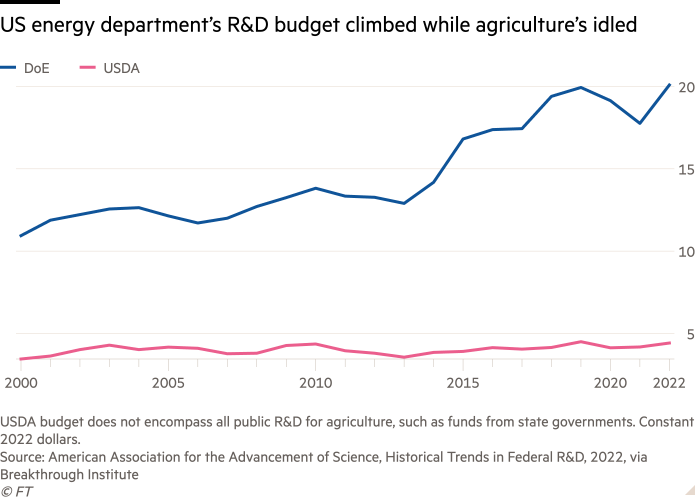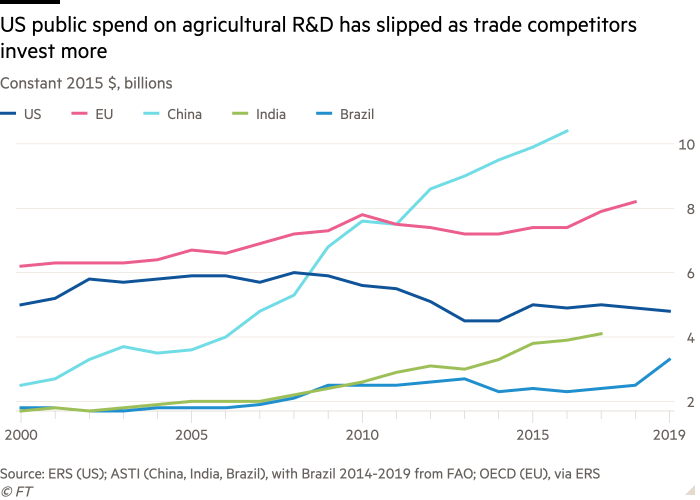
This article is an onsite version of our Moral Money newsletter. Premium subscribers can sign up here to get the newsletter delivered three times a week. Standard subscribers can upgrade to Premium here, or explore all FT newsletters.
Visit our Moral Money hub for all the latest ESG news, opinion and analysis from around the FT
Welcome back. Jigar Shah, the director of the once-obscure Loan Programs Office at the US Department of Energy has become something of a folk hero to clean-energy activists, with one think-tank researcher recently calling him “the world spirit”.
Climate campaigners’ love affair with the loan office stems from a broader fad for public finance, which can be more patient than volatile venture capital — and can be steered towards sectors that meet public goals. Now, supporters of decarbonisation in sectors beyond energy want in on the action. For today’s newsletter, I report on one such proposal, and whether it could draw in more private capital for green innovation in agriculture.
Thanks for reading.
Climate Finance
Financing US agriculture’s green tech revolution
Clean tech manufacturing plants are mushrooming across the US in the wake of the Biden administration’s industrial policy spending. Tax incentives have seeded factories in strategic sectors such as electric vehicles and their supply chain parts.
The pandemic and recovery stimulus helped set off an economic revitalisation that is still under way. Yet one of the US’s biggest and most polluting sectors, the farm industry, has been largely left in the dust of the green-tech blast-off.
The US is the biggest agricultural exporter in the world, and farming is responsible for about 10 per cent of national emissions. Technologies for cutting that pollution are under development, from green fertilisers to methane-reducing feed for livestock.
But lacklustre private investment and volatile venture capital have been slow to bring those tools from the lab bench to commercial deployment, according to a report published today by the eco-modernist Breakthrough Institute. The California-based think-tank argues that the US has recently demonstrated an arsenal of public tools to steer more finance into emerging green technologies — and it should deploy them in the farm sector.
Breakthrough calls for a loan office at the Department of Agriculture, modelled on the success of the Loan Programs Office, which was given more firepower in recent legislation. The report argues that the government should support several industrial policy programmes to bring food and farm decarbonisation technologies to market.
Food sector needs innovation
The US has a long history of public funding for agricultural research. The publicly owned Tennessee Valley Authority, best known for bringing electric lighting to rural America, once housed a fertiliser programme that claimed credit, as of 2008, for having helped to develop or improve three-quarters of fertiliser used globally. The USDA’s Economic Research Service found that from 1900 to 2011, every $1 of US spending on public agricultural research and development generated, on average, $20 in benefits.
But US public spending on agricultural R&D peaked in 2002, and over the next two decades fell by about a third, settling down at levels seen in the 1970s, according to the ERS. Investment remained slack even as public spending on clean energy research and development climbed. The US has meanwhile lagged behind major trade competitors’ growing investment in farming, with China becoming the world’s largest funder of agricultural R&D.

President Joe Biden’s Inflation Reduction Act set aside nearly $20bn in new conservation funding for agriculture, but it was primarily for the adoption of existing environmental practices in farming and ranching, such as no-till agriculture and cover crops.
Those are important tools, Breakthrough report co-author Emily Bass told me, but their benefits were primarily for the local environment — like preserving water and soil health — rather than making big inroads on cutting carbon to curb climate change. Plus, she said, the government should look beyond subsidising the adoption of already mature technologies.
“There is opportunity for existing USDA programmes, and new initiatives, to place more of a premium on innovation,” Bass said.
The report looks at emerging tools ranging from plant-based meat substitute production to crushing rocks and spreading the dust on cropland, which has the potential both to trap carbon from the air and to improve crop yields. A wide array of technologies face similar financing hurdles, the report argues, in particular because of the volatility and short-term funding cycles of venture capital.
VC appetite for climate tech grew 10-fold between 2013 and 2018, according to PwC. But 2022 saw a contraction in “critical early-stage funding required to scale up the next wave of climate tech”, which continued in 2023. And within climate technology, food and land use remain underinvested compared with sectors such as mobility and energy, according to the Climate Policy Initiative.
As a result, promising lab prototypes can languish in the so-called “valley of death” between experimental success and being awarded a big enough contract to achieve commercial viability.

Growing support for public finance
One case study is vertical agriculture. Indoor farms with temperature-controlled environments can deploy an army of new techniques in robotics and artificial intelligence to cut the land and water used to produce leafy greens — as well as the distance vegetables must be transported to reach the dinner table.
Vertical farms also boast that they can rely on renewable energy to operate their LED lighting systems, ventilation systems and other precision technology. But after attracting a $1.7bn influx in 2022, according to data provider Dealroom, investment fell off sharply, as the sector faced high energy costs and struggled to turn a profit.
Alternative proteins, such as lab-grown or plant-based meat substitutes, are another sector where the need for public financing is clear, Breakthrough argued, because of high year-to-year variance in private investment. A commercial scale lab-grown meat facility capable of producing 10,000 metric tons of cultivated meat can have capital costs as high as $450mn, according to a 2021 study.
Supporters of public finance say that it can provide a longer investment runway for risky technologies to achieve profitability, assisting promising start-ups with everything from leasing real estate to buying bioreactors in bulk.
Yakov Feygin, a researcher on green banking at the think-tank Center for Public Enterprise, told me the Loan Programs Office had helped supporters of public finance make the case that such programmes could catalyse investment in strategic sectors. The agency had focused on “large, charismatic technologies which are really unbankable right now”, he said, such as nuclear and geothermal energy.
Darpa, the renowned US defence department research agency that helped develop breakthrough technologies from the internet to mRNA vaccines, has also become something of a celebrity tool of industrial policy, spawning copycats at the departments of transportation, energy and commerce.
The Breakthrough report argued for fully funding a programme modelled on Darpa — the Agriculture Advanced Research and Development Authority, or Agarda — which was created as a pilot initiative in 2018 and assigned $50mn per year in funding, but has received only $2mn in funding to date.
In addition to the programmes modelled on Darpa and the LPO, the report argues for funding agricultural decarbonisation through other channels trialled during the pandemic. It recommends reviving a 2021 programme that guaranteed loans of up to $40mn for infrastructure in the middle of the food supply chain, such as food processing and cold storage facilities. The programme made at least $539.5mn in loans, but its remaining funds were rescinded last year in the US’s Fiscal Responsibility Act debt-ceiling deal.
Others argued that de-risking private investment in farming, one of the most heavily subsidised industries in the US economy, should come with more provisions to improve competition. A USDA researcher who asked not to be named said that the recommendations in the Breakthrough report were “generally good, kind of vanilla”.
“Most [dominant companies] across industries and shareholders would like these recommendations, which to me amount to public subsidies for risky R&D, a tale as old as time . . . with monopolists acquiring gains and profiting,” the researcher told me.
A stronger version, the researcher added, would include provisions to improve competition in the notoriously consolidated farm sector, such as universal licensing requirements for patents developed with publicly funded research.
For now, Breakthrough’s Bass said, “farmers are under more and more pressure from . . . sustainability targets and demands being made not only by the US government, but also within supply chains and by multinationals”. The public sector should take a more direct hand in developing decarbonisation technologies, she added, because the energy transition “can’t just happen at the multinational conglomerate level — it has to come down to the farm gate”.
Smart read
Initial results suggest that voters have overwhelmingly elected Claudia Sheinbaum, a climate scientist who served on the UN’s Intergovernmental Panel on Climate Change, to be Mexico’s next president. Michael Stott and Christine Murray report on the former campus protester who will probably soon manage the finances of state oil firm Pemex.
Recommended newsletters for you
FT Asset Management — The inside story on the movers and shakers behind a multitrillion-dollar industry. Sign up here
Energy Source — Essential energy news, analysis and insider intelligence. Sign up here